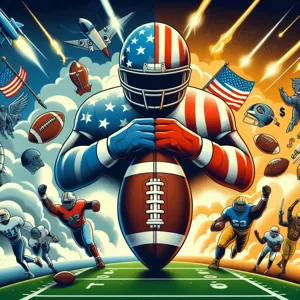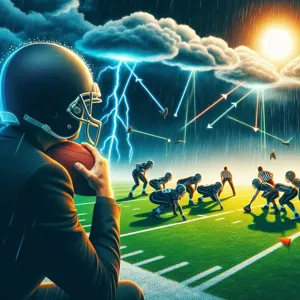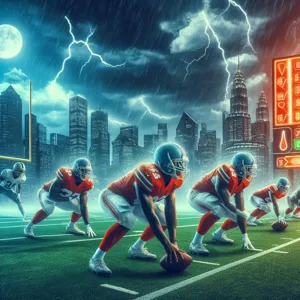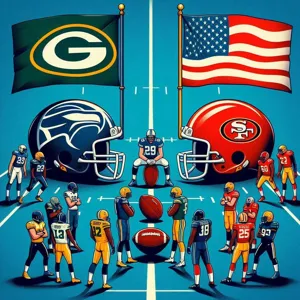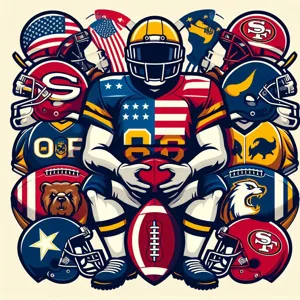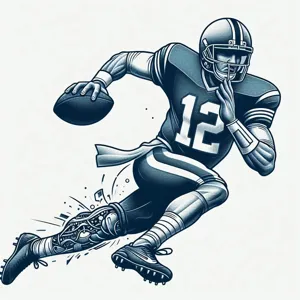The backhand slice is one of the most nuanced yet powerful shots in a tennis player’s arsenal, often serving as a game-changer during intense matches.
Whether you’re a seasoned player looking to refine your technique or a beginner eager to elevate your game, mastering this shot can unlock new levels of consistency and precision on the court. With its unique blend of finesse and strategy, the backhand slice not only adds variety to your gameplay but also empowers you to control rallies and dictate the pace of the match. In this blog post, we’ll dive deep into the essential tips and techniques that will help you perfect your backhand slice—covering everything from grip and stance to timing and follow-through. Get ready to transform your game and impress your opponents with a slice that’s as reliable as it is effective!
1. Understanding the Backhand Slice: An Overview

The backhand slice is a fundamental yet often overlooked shot in tennis that can be a game-changer when mastered. Unlike a traditional backhand, which employs a full swing to drive the ball, the slice relies on a delicate touch and an understanding of spin dynamics. This technique involves striking the ball with a slightly open racket face, creating backspin that alters its trajectory and bounce. The result is a low, skidding shot that can disrupt your opponent’s rhythm and force them to adjust their positioning.
A well-executed backhand slice can serve multiple purposes in your arsenal. It’s particularly effective for defensive play, allowing you to return tricky shots with control while giving you time to reposition on the court. Additionally, the slice can be a strategic weapon, especially when used to approach the net or to change the pace of the game. By mixing it into your rallies, you’ll keep your opponent guessing and create openings for more aggressive shots.
Understanding the mechanics of the backhand slice is crucial for developing consistency and precision. Focus on your grip; a continental grip is often recommended, as it allows for better control and spin. Your stance should be balanced, with your knees slightly bent and your weight shifting from back foot to front foot as you make contact with the ball. The follow-through is equally important—aim for a smooth, upward trajectory to ensure that the ball clears the net while maintaining that all-important backspin.
As we delve deeper into mastering the backhand slice, remember that practice is key. Regular drills focusing on this shot will enhance your muscle memory and boost your confidence on the court. By developing a solid understanding of the backhand slice, you’ll not only improve your overall game but also add a versatile tool to your competitive repertoire.
2. The Importance of the Backhand Slice in Tennis
The backhand slice is often an underappreciated shot in the tennis arsenal, yet it holds incredible significance in a player’s overall strategy. Unlike the powerful groundstrokes that dominate the game, the backhand slice is a subtle and tactical shot that can shift the momentum of a match. When executed correctly, it can not only disrupt your opponent’s rhythm but also create opportunities for you to dictate play.
One of the primary advantages of the backhand slice is its ability to impart backspin, causing the ball to stay low and skid upon bouncing. This can be particularly effective against players who prefer to attack with aggressive shots, as the low bounce often forces them to adjust their stance and timing. By utilizing the slice, you can draw your opponent into the net, setting up the perfect opportunity for a volley or a powerful follow-up shot.
Moreover, the backhand slice is a fantastic defensive tool. When you find yourself on the back foot, a well-timed slice can buy you valuable time to reposition and regain your footing. It allows you to neutralize an aggressive rally and gives you the chance to reset the point, making it an essential shot for players at every level.
In doubles play, the backhand slice shines as a strategic weapon. Its ability to change the direction and angle of the ball can create confusion amongst opponents, often leading to openings for effective poaching or positioning at the net. By mastering this shot, you can enhance your overall game and become a more versatile player, capable of handling various styles and situations on the court.
Ultimately, the backhand slice is more than just a defensive maneuver; it’s an offensive weapon that can elevate your game. Embracing its importance not only improves your shot selection but also enriches your tactical understanding of the game, setting the stage for a more consistent and precise performance on the court.
3. Key Grip Techniques for a Successful Backhand Slice

When it comes to executing a successful backhand slice, the grip you choose can drastically influence both the consistency and precision of your shot. Mastering key grip techniques is essential for players looking to refine their backhand slice and gain an edge over their opponents.
The most commonly recommended grip for a backhand slice is the continental grip. To achieve this grip, imagine holding a hammer and position your racquet as if you’re about to strike a nail. This grip allows for a natural wrist motion, enabling you to impart the necessary backspin on the ball. By using the continental grip, you’ll also find it easier to transition into other shots, such as volleys or overheads, without having to adjust your hand position significantly.
For players who are more comfortable with their dominant hand, the eastern backhand grip can also be utilized. This grip involves placing the base knuckle of your index finger on the third bevel of the racquet handle. This adjustment provides a more stable contact point and helps generate a bit more topspin, which can be advantageous when your opponent is playing aggressively.
Regardless of the grip you choose, practice is key. Begin by hitting against a wall or with a partner, focusing on maintaining a firm yet relaxed grip. Pay attention to how your grip influences the ball’s trajectory and spin. Over time, developing a feel for the correct grip will not only enhance your backhand slice but will also instill confidence as you face various opponents on the court.
Ultimately, consistency in your grip technique leads to more precision in your shots. By experimenting with both the continental and eastern grips and understanding their unique benefits, you’ll be well on your way to mastering the backhand slice and elevating your game to new heights.
4. Stance and Footwork: Setting Up for the Slice
When it comes to mastering the backhand slice, your stance and footwork are crucial components that directly influence your consistency and precision. A solid foundation begins with your positioning on the court. Stand with your feet shoulder-width apart, knees slightly bent, and weight evenly distributed. This stance not only provides balance but also allows for quick adjustments as the ball approaches.
As the ball comes toward you, make sure to pivot your outside foot—typically the right foot for right-handed players—while stepping into the shot with your front foot. This movement should be fluid, enabling you to maintain a low center of gravity, which is essential for executing a successful slice. Remember, the slice relies on a relaxed grip and smooth, controlled motion; by engaging your legs and core during your swing, you can generate the necessary power without sacrificing accuracy.
Moreover, your footwork should be anticipatory. Always be ready to adjust your position based on the trajectory and speed of the incoming ball. Quick, lateral movements will help you set up properly and get into the ideal stance. Practice lateral shuffles and practice drills that focus on changing direction swiftly to ensure that your footwork becomes second nature.
In essence, mastering your stance and footwork will not only enhance your slice but also your overall game. With the right setup, you’ll find that your backhand slice becomes a reliable weapon, capable of cutting through the court with precision and finesse. Remember, every great shot starts with the right stance—so invest the time to perfect it, and watch your consistency soar.
5. The Swing Path: How to Execute the Perfect Slice

To master the backhand slice, understanding the swing path is crucial. The swing path determines not only the trajectory of your shot but also the consistency and precision with which you can deliver it. Here’s how to execute the perfect slice:
Start by positioning yourself correctly. As the ball approaches, ensure you’re in a stable stance with your feet shoulder-width apart, allowing for a solid foundation. The key to a successful slice lies in your grip; an eastern or continental grip works best for this shot, as it facilitates the angle needed to create that signature backspin.
As you prepare to swing, visualize an upward arc. Your swing should begin low and travel upward, cutting through the ball with a slightly open racket face. This upward motion is what imparts backspin, causing the ball to float and dip unexpectedly on the other side of the net. Focus on maintaining a smooth motion throughout the swing—think of it as a gentle, sweeping gesture rather than a jerky or forceful action.
The follow-through is equally important, as it helps ensure that your slice lands where you intend. After making contact, allow your racket to continue its path upward and across your body. This not only adds to the spin but also prepares you for your next shot. Aim for a finish that resembles a high-five with the racket, with the head of the racket pointing towards your target.
Practice is essential for honing this technique. Set up drills that allow you to focus on your swing path and follow-through without the pressure of a match. Over time, you’ll build muscle memory, enabling you to execute the backhand slice with greater ease and confidence during gameplay. Remember, consistency and precision take time to develop, but with dedication to mastering your swing path, you’ll soon find yourself slicing with finesse and accuracy.
6. Timing and Rhythm: Finding Your Groove
When it comes to mastering the backhand slice, timing and rhythm play a crucial role in achieving both consistency and precision. The backhand slice is not just a technical shot; it’s a dance between your body and the ball, requiring you to find your groove on the court.
To develop this rhythm, begin by focusing on the timing of your swing. As the ball approaches, observe its trajectory and speed. The ideal moment to make contact is when the ball is at the height of your waist, allowing you to generate the necessary slice while maintaining control. If you rush your shot, you risk mishitting the ball, leading to inconsistent performance. Practicing your footwork is equally important; ensure you’re well-positioned to intercept the ball, enabling a smooth and fluid motion.
Incorporating a consistent pre-shot routine can help establish your rhythm. Take a deep breath, visualize your shot, and settle into your stance. This helps to calm your nerves and focuses your mind on the execution of the slice. As you swing, allow your non-dominant hand to guide the racquet, ensuring your follow-through is smooth and elongated. This not only aids in generating spin but also helps you maintain balance.
Finally, remember that developing a natural rhythm takes time and practice. Engage in drills that emphasize timing, such as hitting with a partner or using a ball machine, and pay close attention to the feedback your body provides. As you continue to refine your timing and rhythm with the backhand slice, you’ll find that consistency and precision naturally follow. So next time you step onto the court, listen to the rhythm of your game and let it guide you to slice success!
7. Common Mistakes to Avoid When Hitting a Slice

When it comes to mastering the backhand slice, avoiding common mistakes can make all the difference in achieving consistency and precision. Here are several pitfalls to watch out for that can hinder your performance:
**1. Ignoring the Grip:** One of the most critical aspects of executing a successful slice is your grip. Many players make the mistake of using an improper grip, leading to ineffective shots. The continental grip is typically recommended for slices, allowing for better angle control and spin. If you find your slices lack depth or are too erratic, take a moment to reassess your grip and make necessary adjustments.
**2. Poor Footwork:** Footwork is the foundation of any solid shot, and the slice is no exception. A common mistake is failing to position yourself correctly before making contact with the ball. Ensure you’re moving your feet to get into the optimal position, as this will allow you to generate the necessary power and spin. Remember, proper footwork not only helps you hit the ball cleaner but also prepares you for your next shot.
**3. Overhitting the Slice:** Many players believe that more power equals a better slice, leading them to swing too hard. In reality, a well-executed slice relies on finesse rather than brute strength. Focus on a smooth, controlled swing that emphasizes technique over power. This approach will produce a more precise shot that stays low and skims the court, making it more challenging for your opponent to return.
**4. Inconsistent Follow-Through:** The follow-through is crucial for maintaining control and direction on your slice. A frequent mistake is to either cut the follow-through short or to finish too high, which can lead to erratic ball placement. Aim for a low and smooth follow-through that complements your swing path, helping ensure that your slices land where you intend.
**5. Neglecting Spin:** Spin is what gives the backhand slice its effectiveness, and failing to incorporate it can result in flat, predictable shots. Many players forget to brush down on the ball, which is essential for generating the slice’s signature backspin. Focus on the brush of your racket against the ball as you swing, allowing for that crucial spin to take shape.
By being mindful of these common mistakes, you can refine your backhand slice technique and elevate your game. Remember, every player makes errors; the key is to learn from them and continually seek improvement. With practice and attention to detail, your slices will become a reliable weapon in your tennis arsenal.
8. Drills to Improve Consistency with the Backhand Slice
To truly master the backhand slice, incorporating targeted drills into your practice routine is essential. These drills not only enhance your consistency but also help you develop the precision necessary to keep your opponents guessing. Below are some effective drills designed to refine your backhand slice technique:
**1. Wall Drill:** Find a solid wall and stand a few feet away. Begin by hitting backhand slices against the wall, focusing on your grip and follow-through. Pay attention to the angle of your racket as you strike the ball; aim for a smooth, controlled motion. As you gain confidence, increase the distance from the wall and the intensity of your shots. This drill helps you work on consistency while also allowing you to adjust to different ball speeds and angles.
**2. Target Practice:** Set up targets on the opposite side of the court, using cones or even towels to define your aim points. Partner with a friend or coach, and take turns hitting backhand slices aimed at these targets. Start with larger targets and gradually decrease their size as your accuracy improves. This drill not only hones your consistency but also challenges your ability to place the ball strategically.
**3. Feed and Return Drill:** Have a partner feed you balls at varying heights and speeds. As they deliver each ball, focus on executing your backhand slice with proper mechanics. This drill simulates match conditions and helps you learn how to adapt your slice to different shots. Make sure to practice both defensive and offensive slices, as this will prepare you for real-game scenarios.
**4. Crosscourt Rally:** Pair up with a partner and engage in a crosscourt rally, using only backhand slices. This drill forces you to maintain a steady rhythm and develop a feel for the ball while improving your consistency. It also encourages you to focus on footwork and positioning, which are crucial for executing effective slices during matches.
**5. Progression Drill:** Begin at the service line and execute backhand slices, then gradually move further back on the court. This progression helps you build strength and control as you practice hitting slices from various distances. It’s a great way to reinforce your technique while bolstering your confidence in your backhand slice.
By incorporating these targeted drills into your training regimen, you’ll be well on your way to mastering the backhand slice. Consistency and precision will become second nature, allowing you to elevate your game and keep your opponents on their toes. Remember, practice makes perfect, so dedicate time to these drills and watch your slice transform into a powerful weapon on the court.
9. Incorporating Spin: The Role of Topspin and Slice
In the world of tennis, mastering the backhand slice isn’t just about hitting the ball; it’s about understanding how spin can elevate your game to new heights. A well-executed backhand slice can be a game-changer, but it’s the incorporation of topspin and slice that truly defines its effectiveness.
When we talk about topspin, think of it as the secret sauce that adds a unique dimension to your shots. By imparting topspin to your backhand slice, you create a trajectory that not only clears the net with ease but also dips sharply, making it challenging for your opponent to return. This spin helps in keeping the ball low after it bounces, which is especially useful when dealing with aggressive players who prefer to hit from their baseline. The topspin allows you to maintain control while pushing your opponent back, giving you the upper hand in rallies.
On the flip side, the slice is your trusty ally for varying the pace and trajectory of your shots. When you properly slice the ball, you create a side spin that causes it to skid off the court, often catching your opponent off-guard. This is particularly effective on slower surfaces, where the ball tends to stay low, forcing your opponent to adjust their stance and timing. The unpredictable nature of a well-placed slice can disrupt their rhythm and open up opportunities for you to attack.
To effectively incorporate both spins into your backhand slice, focus on your racket angle and follow-through. A slightly closed racket face will help you achieve that desired slice, while a more open face can enhance the topspin effect. Practicing these techniques will not only improve the consistency of your shots but also build your confidence on the court. Remember, the key is to vary your shots, mixing in topspin and slice to keep your opponent guessing and create opportunities for winning points.
Incorporating spin into your backhand slice is not just about technique; it’s about strategy. By understanding the nuances of how each type of spin affects the ball’s behavior, you can develop a more versatile and unpredictable game. With dedication and practice, you will not only master the backhand slice but also transform it into a formidable weapon in your tennis arsenal.
10. Practicing Under Pressure: Game Situations for the Slice
Practicing under pressure is crucial to mastering the backhand slice, as real-game scenarios often bring an intensity that can challenge even the most skilled players. To simulate the high-stakes environment of a match, consider incorporating drills that mimic game situations. One effective method is to set up a series of points where you must use your slice as a key shot. This can be as simple as playing a set of mini-games, focusing exclusively on hitting slices from different positions on the court.
Start by having a partner feed you balls at various angles and speeds. As you return these shots with a slice, pay close attention to your footwork and positioning—both are paramount for generating the necessary control and spin. You can also enhance this drill by introducing a score element. For instance, award points for successful slice returns that land within specific target areas, pushing you to maintain precision under pressure.
Another excellent drill involves playing points with specific rules: you can only hit a slice on certain shots, such as when receiving a high ball or when your opponent is positioned aggressively at the net. This not only helps you practice your slice but also trains your mind to identify when to use it effectively during real matches.
Finally, consider playing against a partner who applies deliberate pressure by hitting aggressively or placing you in defensive situations. This forces you to rely on your backhand slice as a strategic tool to regain control of the rally. By consistently practicing these game-like scenarios, you’ll build the confidence and muscle memory needed to execute your backhand slice with consistency and precision when it truly counts.
11. Analyzing Professional Players: Slice Techniques in Action
When it comes to mastering the backhand slice, there’s no better source of inspiration than the world’s top tennis professionals. Analyzing their techniques not only allows you to understand the mechanics behind an effective slice but also helps you identify the nuances that elevate their game. Take a moment to watch the likes of Roger Federer, Ashleigh Barty, or Novak Djokovic—their backhand slices are not merely functional; they are strategic weapons that can turn the tide of a match.
As you observe these elite athletes, pay close attention to their stance and grip. Notice how they position their bodies to generate maximum power while maintaining control and balance. For instance, Federer often utilizes a semi-open stance, allowing him to pivot and create angles effortlessly. Barty, on the other hand, showcases a variety of grips, adapting her slice based on the situation—be it a low ball or a high one.
Next, focus on the follow-through. A common characteristic among professional players is their commitment to a complete follow-through. This not only adds spin but also ensures precision in placement. You’ll often see them extend their racquets fully, guiding the ball with purpose and intent, which can be a game-changer when aiming for the sidelines or executing a drop shot.
Don’t overlook the mental aspect of their game as well. Professionals like Djokovic demonstrate exceptional court awareness, anticipating their opponent’s responses and adapting their slice accordingly. This adaptability is crucial; it’s not just about the technique, but also about reading the game and making quick decisions that keep opponents on their toes.
Incorporating these observations into your practice sessions can lead to significant improvements in your own backhand slice. Record yourself during drills, compare your form with that of the pros, and make adjustments as needed. Over time, you’ll develop a slice that not only mirrors the elegance of professional players but also possesses the consistency and precision needed to dominate your matches. So grab your racquet, hit the courts, and let the pros be your guide on the journey to mastering the backhand slice!
12. Adjusting Your Slice for Different Court Surfaces
When it comes to mastering the backhand slice, understanding how to adjust your technique for different court surfaces is crucial. Each surface—be it clay, grass, or hard court—offers unique characteristics that can significantly affect the bounce and speed of the ball.
On clay courts, for instance, the softer surface tends to absorb energy, resulting in a slower ball and a lower bounce. To adapt your slice for this environment, aim for a more exaggerated chopping motion. This will help you create a deeper shot that stays low and skids off the court, making it difficult for your opponent to attack. Focus on using your body weight to drive through the ball, ensuring that you maintain a solid follow-through to keep your slice effective and controlled.
Conversely, grass courts present a faster playing surface with a lower bounce. Here, your backhand slice should be more compact and aggressive. A shorter swing path with a firm wrist will enable you to cut through the ball with precision, creating a sharp angle that can pull your opponent wide off the court. This adjustment not only helps keep your slice effective but also allows for quicker transitions into the net, setting you up for potential volleys.
On hard courts, where the bounce is more predictable and consistent, you can leverage both techniques. A balanced approach will serve you well here; employ a more traditional slice when you want to keep the ball low and force errors, while using a more aggressive slice to change the pace and keep your opponent guessing.
Incorporating these adjustments into your training can elevate your backhand slice, making it a reliable weapon regardless of the surface. Embrace the nuances of each court, and watch as your consistency and precision soar, setting you apart as a master of the slice.
13. How to Use the Slice as a Defensive Tool
The backhand slice is not just a fancy shot to add to your repertoire; it can be a powerful defensive tool when employed correctly. Mastering this technique can transform your gameplay, allowing you to regain control in challenging situations. Here’s how to harness the slice effectively as a defensive maneuver.
Firstly, consider the scenarios where the slice can be most beneficial. When your opponent is aggressively attacking and forcing you into deep corners of the court, a well-executed slice can buy you precious time. By chopping down on the ball and creating a low bounce, you can disrupt your opponent’s rhythm. This shot not only slows down the pace of the game but also makes it difficult for your rival to hit aggressively, essentially taking the initiative away from them.
To execute the slice defensively, focus on your stance and grip. Position yourself with your feet shoulder-width apart, knees slightly bent, and weight shifted to your back foot. This will allow for better balance and control as you prepare to strike. Use an eastern or continental grip for your slice, which will offer you the necessary angle to create that signature low trajectory.
As you make contact with the ball, ensure that your racket face is slightly open, and follow through with a smooth, downward motion. The slice comes from a clean, precise stroke rather than sheer power, so aim for a controlled swing that generates spin. This technique not only keeps the ball low but can also create unpredictable trajectories, making it tricky for your opponent to return.
Finally, don’t underestimate the importance of footwork when using the slice defensively. Quick, deliberate movements will help you position yourself effectively, allowing for better shot execution. As you hit the slice, anticipate your opponent’s response and be ready to follow up with your next shot, whether it’s another defensive slice or a more aggressive approach.
By integrating the backhand slice into your defensive strategy, you can enhance your overall game, turning moments of pressure into opportunities for counterplay. With practice, this shot will not only build your consistency but also boost your confidence on the court, making you a formidable opponent.
14. Mental Strategies: Building Confidence in Your Slice
Mastering the backhand slice isn’t just about perfecting your technique; it’s equally about cultivating the right mindset. The mental aspect of your game can often make the difference between a confident, consistent slice and one that falters under pressure. Building confidence in your slice begins long before you step onto the court. Here are some key mental strategies to enhance your performance.
First, visualization is a powerful tool. Spend some time imagining yourself executing the perfect backhand slice. Picture the ball spinning off your racket with precision, gliding over the net, and landing exactly where you intended. This mental rehearsal can significantly boost your confidence, making the actual execution feel more familiar and achievable.
Next, embrace positive self-talk. Replace any negative thoughts with affirmations that reinforce your skills. Phrases like “I have a strong slice” or “I can control the ball” can shift your focus from doubt to determination. The power of belief can’t be underestimated; when you trust in your abilities, you’re more likely to perform well under pressure.
Additionally, practice mindfulness techniques to stay present during your matches. Often, anxiety arises from worrying about the outcome rather than focusing on the shot at hand. Incorporate breathing exercises or brief moments of meditation into your routine to help clear your mind and maintain focus, especially during critical points in the game.
Lastly, set realistic goals for your slice during practice sessions. Instead of aiming for perfection, concentrate on consistency. Celebrate small victories, such as successfully executing a specific number of slices in a row, to reinforce a sense of accomplishment. This incremental approach will help build your confidence over time, making you more resilient during competitive play.
By integrating these mental strategies into your training regimen, you’ll not only enhance your backhand slice but also cultivate an unshakeable confidence that will serve you well in every match. Remember, the mind is a powerful ally on the court—harness it, and watch your game elevate to new heights.
15. Conclusion: Embracing the Backhand Slice in Your Game
In conclusion, embracing the backhand slice can be a game-changer for players at any level. This nuanced shot not only adds depth to your arsenal but also enhances your overall gameplay by providing strategic advantages against your opponents. By mastering the backhand slice, you can effectively disrupt your opponent’s rhythm, create awkward angles, and take control of the point.
To truly integrate the backhand slice into your game, remember to focus on the fundamentals: maintain a proper grip, balance your body, and use your legs to generate power and stability. Regular practice will help you develop the muscle memory needed for consistency and precision, ensuring that your slice becomes a reliable weapon during matches.
Moreover, don’t shy away from experimenting with different variations of the slice. Adjust your speed, spin, and trajectory to keep your opponents guessing and enhance your tactical play. Whether you’re using it as a defensive maneuver or an offensive surprise, the backhand slice can elevate your performance on the court.
Ultimately, the key to success with the backhand slice lies in your willingness to embrace it as part of your game. As you cultivate this skill, you’ll not only improve your own play but also gain the confidence to challenge your opponents in new and exciting ways. So grab your racket, head to the court, and start slicing your way to victory!
In conclusion, mastering the backhand slice is an essential skill that can elevate your tennis game to new heights. By incorporating the key tips we’ve discussed—such as proper grip, body positioning, and follow-through—you can achieve greater consistency and precision with every shot. Remember, practice is vital; the more you work on your technique, the more natural it will become. As you integrate the backhand slice into your play, you’ll not only enhance your overall performance but also gain a strategic advantage over your opponents. So grab your racket, hit the court, and start perfecting your slice—your game will thank you for it! Happy playing!

